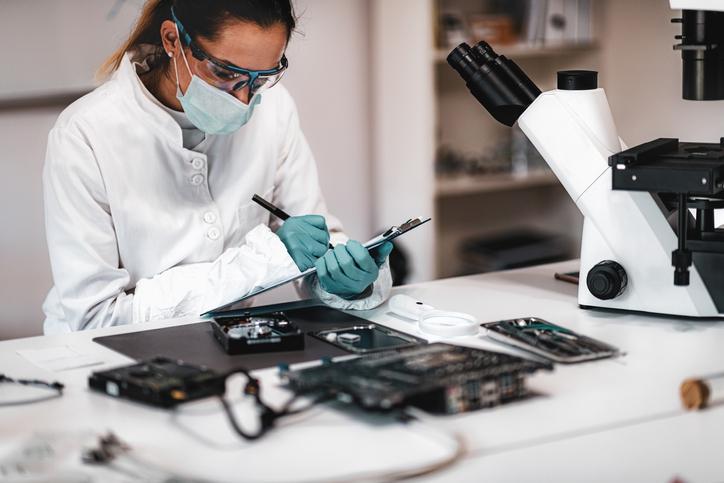
A look behind the scenes
Data loss can be equally devastating for companies and private individuals. Whether caused by technical failure, hardware error or human error, the loss of important data can have a significant impact. In such situations, data recovery in a cleanroom is often the last hope for recovering data that was thought to be lost. But what is behind this complex process and what steps are necessary?
Recover your data in 4 steps
- Submit the data carrier: The first step on the way to data recovery is to submit the affected data carrier. Our customers fill out a diagnostic registration form, which is then sent to them by e-mail. After the registration has been confirmed and printed out, the form is sent to the relevant company together with the data carrier or handed in personally on site.
- Analysis: As soon as the data carrier arrives at the data recovery service, a thorough analysis is carried out. This analysis is crucial to determine the exact damage to the data carrier. The diagnostic report resulting from this analysis also contains an offer for data recovery.
- Data recovery: The actual data recovery begins after the customer has accepted the offer. This restores all available data on the damaged data carrier. A clear file list is created and sent to the customer for checking. If the customer is satisfied and confirms that the recovered data is correct, it is transferred to an encrypted transport medium, typically a USB stick or an external hard disk.
- Return of the data: After successful data recovery, the recovered data is securely packaged on the transport medium and sent to the customer or made available for collection. Identification by means of an official ID is required at the time of collection to ensure that the data is handed over to the correct person.
Behind the scenes: The clean room
The clean room is the heart of every data recovery laboratory. Its construction is designed to remove harmful particles such as dust, dirt and other impurities from the environment. These particles could damage the sensitive data carriers and jeopardize the success of the data recovery. A cleanroom follows strict standards and protocols to ensure optimal conditions for data recovery processes. Data recovery in a cleanroom is a highly specialized process that requires expertise, experience and specialized equipment. By adhering to strict protocols and standards, we ensure that data recovery is carried out under the best possible conditions and that the integrity of the recovered data is guaranteed.
How does data recovery in the cleanroom work?
Before the actual data recovery process begins, the clean room is prepared. This means that all surfaces are thoroughly cleaned and disinfected to ensure that no particles can enter the environment. Staff working in the cleanroom must wear special protective clothing to minimize the risk of contamination. These typically include overalls, gloves, hoods and face masks. The air in the clean room is cleaned by high-performance air filtration systems. These systems remove particles from the air and thus ensure a dust-free environment. Special tools and equipment are used for data recovery in the clean room, which enable precise manipulation of the data carriers without damaging them. In order to access the data, the damaged data carrier must be opened. This is done under controlled conditions in the clean room to minimize the risk of contamination. This is followed by the actual data extraction. Damaged parts of the data carrier are repaired or bypassed in order to restore the data. Once the data has been extracted, it is transferred to a secure medium, typically an external hard disk. This transmission also takes place in a clean room to ensure the integrity of the data. Once the data has been successfully recovered, the data carrier is properly resealed and cleaned. The cleanroom must also be thoroughly cleaned and disinfected again to prepare it for the next use.
